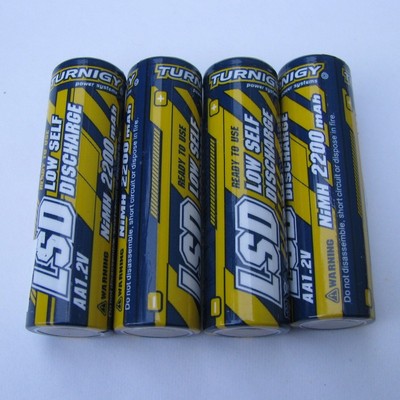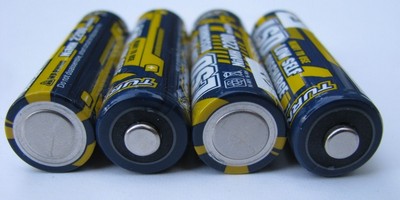I got eight Turnigy 2200 mAh LSD AA batteries from Hobby King a month ago. These batteries are $1.29 each, but postage rates are pretty high ($6.99 shipping for just these 8 batteries, though they had tracking, were in a box instead of an envelope, and arrived pretty quickly). I posted results in the BLF Battery Data Base thread for initial discharge out of the package and capacity after recharging the batteries to full. I will test 2 batteries each at 1 month, 3 months, 6 months, and 1 year to see how well they hold their charge.
Update: Note that these batteries seem to have been replaced by Turnigy 2400 mAh LSD AA batteries for $1.59 each. Now available in 2550mAh 4-packs for $5.99. Also available from US, UK, and EU warehouses.
| Cell | Initial Discharge |
Initial Capacity |
Time | Capacity | Percent | Avg |
|---|---|---|---|---|---|---|
| 1 | 1667 | 2411 | 1 month | 2104 | 87.3% | |
| 2 | 1654 | 2318 | 1 month | 2051 | 88.5% | 87.9% |
| 3 | 1644 | 2299 | 3 months | 2020 | 87.9% | |
| 4 | 1645 | 2385 | 3 months | 2051 | 86.0% | 86.9% |
| 5 | 1631 | 2344 | 6 months | 1950 | 83.2% | |
| 6 | 1642 | 2343 | 6 months | 1927 | 82.2% | 82.7% |
| 7 | 1683 | 2368 | 13 months |
1952 | 82.4% | |
| 8 | 1650 | 2333 | 13 months | 1936 | 83.0% | 82.7% |
| Avg. | 1652 | 2350 | ||||
| 1 | RETEST | 2411 | 12 months | 1932 | 80.1% | |
| 2 | RETEST | 2318 | 12 months | 1894 | 81.7% | 80.9% |
Initial: I used my C9000 to discharge the batteries out of the package at 500mA and then did a Refresh/Analyze to get the capacity readings (in mAh). Charge and discharge are both at 1000mA. The initial results were good and very consistent. Eneloops and Duraloops usually come in just under 2000. What is impressive about this is that if these batteries can maintain 75% of their charge after a year (1763 mAh), they would have more capacity than Eneloops which retain 85% of their charge (1700 mAh).
1 month results: I got the first self-discharge results today and will update this post over time. A little disappointing that they had dropped 12% in just one month given that Eneloops are only supposed to drop 15% in one year, but the results are pretty similar to the test I ran on Sony Cycle Energy 1000mAh cells which were 88.1% after a month and still came in at 74.7% after a year.
3 month results: Wow, 87%! These things barely dropped from the 1-month values. At 3 months their remaining capacity is the same or higher than freshly charged Eneloops. And these two were quite consistent: after 2 hours of discharge, they were both at 1.08V.
6 month results: 83%. Not bad at all. Because of the higher initial capacity, they are down to about what you will get out of a freshly charged Eneloop. This is better than the Sony Cycle Energy cells and seems better than the Turnigy AAA cells which were both around 80% at 6-7 months.
This review uses affiliate links that give me a store credit. I will use this credit to buy and test more batteries.



